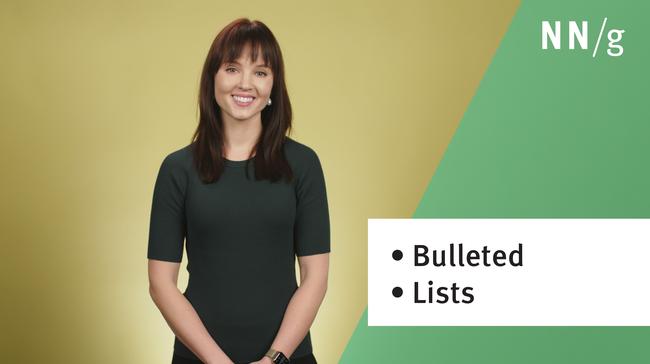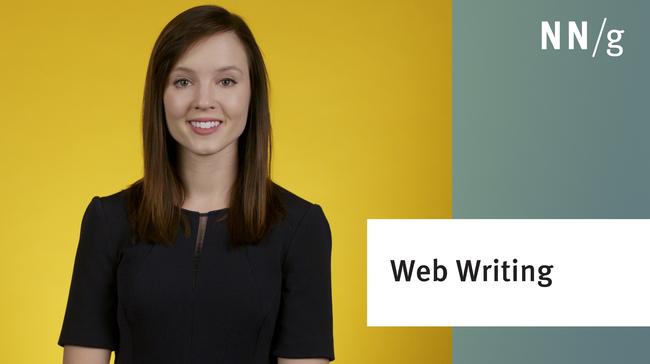Our newest usability study — in preparation for the new Writing Compelling Digital Copy course — tests how well users understand the first 11 characters of a website's links and headlines. For example, we'd represent this article by the "First 2 Wor" string. (Note how the guideline to show numbers as numerals lets me squeeze more meaning into this tiny stump of text.)
Why test text that's so severely truncated? Because online reading is often dominated by the F-pattern. That is, people read the first few listed items somewhat thoroughly — thus the cross-bars of the "F" — but read less and less as they continue down the list, eventually passing their eyes down the text's left side in a fairly straight line. At this point, users see only the very beginning of the items in a list.
On Web and intranet pages, lists occur in many places, including:
- Search engine results pages (SERP)
- Lists of current or archived articles, headlines, press releases, and other news items
- Product listings on category pages
- Table of contents (ToC) listings
- Question lists that serve as ToCs at the top of FAQ (frequently asked questions) pages
- Bulleted or numbered lists, checklists, task steps on a help page or job aid, etc.
Users typically see about 2 words for most list items; they'll see a little more if the lead words are short, and only the first word if they're long. Of course, people don't see exactly 11 characters every time, but we picked this number to ensure uniformity across the sites we tested.
The full text of these short items is microcontent, so this study targeted nano-content. Similar principles apply to both links and headings, but we tested a set of links — again for uniformity.
User Research
Our study included 80 people broadly distributed across age groups, gender, and education.
Younger (<30 years) and college-educated users were over-represented among the test participants. However, because these groups can be expected to have above-average reading skills — and, in the latter case, spend more money online than less educated users — that small skewing shouldn't invalidate the findings. Indeed, whatever difficulties such test users encountered would be even more severe for a broader audience.
We tested 20 different links, one from each of the following 20 sites: Accenture, Amazon.com, Ann Taylor, AT&T, Barclays Bank (UK), Bell Canada, Chase Bank, Dell, Direct.gov.uk, Fidelity Investments, Free Application for Federal Student Aid (USA), Freestyle Media (Australia), Fujitsu, Intel, Norwich Union (UK), Northwestern Memorial Hospital, RMC Labs (Australia), Streamline Solutions (Australia), Topshop (UK), and Xerox.
As the list shows, we tested sites from 3 continents representing a wide range of sectors, including B2B, e-commerce, financial institutions, government, health care, and technology.
We tested two tasks:
- Users were shown truncated links, one at a time, and were asked to predict what they'd find if they clicked on the link. In addition to the 11 characters, we showed users the site's name and a brief site description for additional context.
- Users were shown a list of 10 truncated links, 9 of which were distracters chosen from 60 other sites that weren't otherwise part of our study. We gave users a scenario, asking them to choose the link that would lead to the requested information. For example: "Find information about how to listen to your voicemail messages on your iPhone."
Best Links
Ann Taylor's e-commerce site won this study with the best 11-characters lead. The full link text read "Gift Cards & E-Gift Certificates" and the first 11 characters were "Gift Cards " (including the space after the second word).
85% of users were able to predict where this link led after seeing only the first 11 characters, and 100% of users successfully picked this link (despite the 9 distracters) when asked to "purchase an Ann Taylor gift certificate for a friend."
Barclays Bank scored well for "New custome" (full link: "New customers apply online now"), at least for the task of picking the right link from among the 10, which 95% of users did. And 75% of users had a fairly good idea of where the link would lead when they saw the first 11 characters in isolation.
What characterizes both of these winning links? There's money at stake, so designers are under a mandate to keep it plain and simple, so that the site can make money. Gift certificates are a big revenue source for e-commerce sites, and new accounts are a lifeline for online banking. When users identify and click the right link, both companies can score a win.
The two winning links also showcase principles for effective Web content. Both links
- Use plain language
- Use specific terminology
- Follow conventions for naming common features
- Front-load user- and action-oriented terms
Worst Links
There were a lot of bad links. In fact, for 35% of the links, users who saw only the first 11 characters hadn't the faintest idea of where the links would lead.
The very worst link was from Chase Bank: on its tested link, the initial 11 characters, "Introducing," had no meaning. The full link, "Introducing Chase Exclusives Special Benefits for Checking Customers," is not much better; we're still clueless as to what those "exclusive" and "special" benefits might be.
Not surprisingly, none of the users had a reasonable prediction — or even an inkling — about where "Introducing" might lead. And, when we asked users to pick a link for "Locate any additional benefits you may be eligible for as an existing Chase checking customer," only 15% picked "Introducing" from a list of 10 links.
Links at Directgov ("Working while you study: paying tax") and Xerox ("Profit Accelerator Overview") tied for the second worst. One user actually had a reasonable prediction of where "Profit Acce" would lead, so Xerox didn't lay an egg in the first part of the study the way Directgov did. On the other hand, 25% of users correctly picked the Directgov link from the 9 distracters in the second part of the study, whereas only 5% of users did so for Xerox.
These links are infected by 3 nasties that cause bad content usability:
- Bland, generic words
- Made-up words or terms
- Starting with blah-blah and deferring the information-carrying text to the end
Guiding Users to the Correct Links
It's admittedly harsh to judge a website's design on only the first 11 characters of its links. So, if you replicate this research with your own links, don't cry if you score below Ann Taylor.
Users don't need to predict a link's destination with 100% accuracy based solely on its 11 leading characters. In real life, links aren't truncated on the page. Even if users see only the first 2 words or so during their initial scan, they can immediately read more if their eyes stop on the link.
Thus, only the full link text needs to provide the full information scent:
- Allow users to confidently predict what they'll get if they click.
- Be clearly differentiated from the other links.
- Not be misleading or promise too much.
Nanocontent (first bit of a link) just needs to be good enough that users will sniff the most promising links in full.
Still, low scores in this type of study indicate that you haven't written your site's content for the way users read online, as proven by eyetracking research and many other usability studies. If you score really low, you need an urgent rewrite.
Full Report
Full eyetracking report on how users read on the web is available for download.




